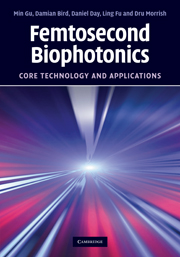Book contents
- Frontmatter
- Contents
- Preface
- 1 Introduction
- 2 Nonlinear optical microscopy
- 3 Two-photon fluorescence microscopy through turbid media
- 4 Fibre-optical nonlinear microscopy
- 5 Nonlinear optical endoscopy
- 6 Trapped-particle near-field scanning optical microscopy
- 7 Femtosecond pulse laser trapping and tweezers
- 8 Near-field optical trapping and tweezers
- 9 Femtosecond cell engineering
- Index
1 - Introduction
Published online by Cambridge University Press: 07 May 2010
- Frontmatter
- Contents
- Preface
- 1 Introduction
- 2 Nonlinear optical microscopy
- 3 Two-photon fluorescence microscopy through turbid media
- 4 Fibre-optical nonlinear microscopy
- 5 Nonlinear optical endoscopy
- 6 Trapped-particle near-field scanning optical microscopy
- 7 Femtosecond pulse laser trapping and tweezers
- 8 Near-field optical trapping and tweezers
- 9 Femtosecond cell engineering
- Index
Summary
This chapter serves as an introduction to this book. Section 1.1 gives a brief review on the development of biophotonics and summarises the main achievements in biophotonics due to the introduction of femtosecond pulse lasers, while Section 1.2 defines the scope of the book.
Femtosecond biophotonics
Biophotonics involves the utilisation of photons, quanta of light, to image, sense and manipulate biological matter. It provides the understanding of the fundamental interaction of photons with biological media and the application of this understanding in life sciences including biological sciences and biomedicine. In that sense, biophotonics research dates back to times when biologists started to use optical microscopy and spectroscopy with a conventional light source such as a lamp. These two forms of classic biophotonic instrument revolutionised biological research and are the classic bridge between photonics and life sciences because they provide a non-destructive way to view the two-dimensional (2D) microscopic world that human eyes cannot, as well as the function of microscopic samples through colour or spectroscopic information.
Biophotonics became a recognised new discipline after the laser was invented in 1960. Laser light is fundamentally different from conventional light in the sense that it possesses high brightness in a narrow spectral window, is highly directional, and exhibits a high degree of coherence. Since 1960, these unique features have facilitated many important applications of laser technology in biological and biomedical studies. One of the important milestones in this area is the combination of laser light with an optical microscope, which led to laser scanning confocal microscopy.
- Type
- Chapter
- Information
- Femtosecond BiophotonicsCore Technology and Applications, pp. 1 - 8Publisher: Cambridge University PressPrint publication year: 2010



